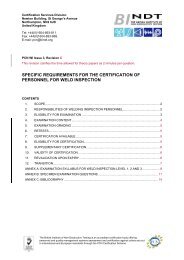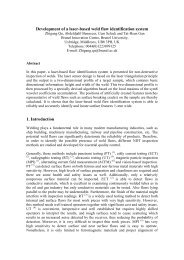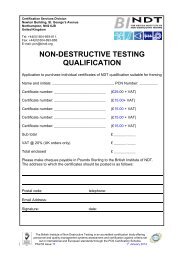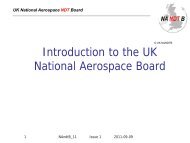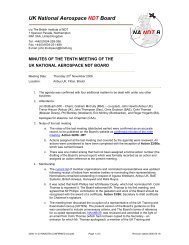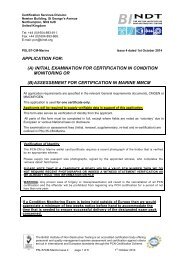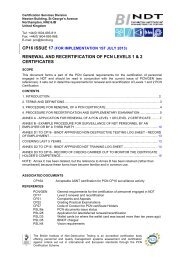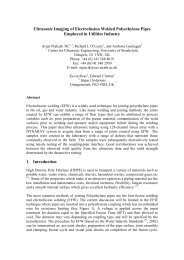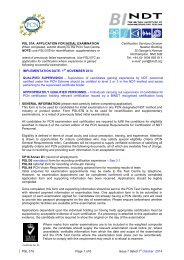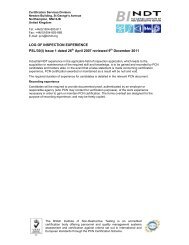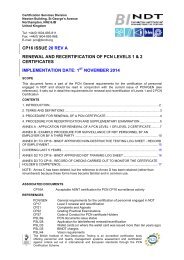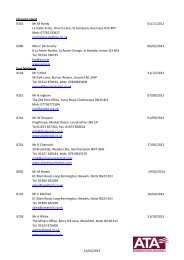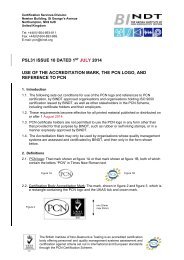PED/15 - BINDT
PED/15 - BINDT
PED/15 - BINDT
You also want an ePaper? Increase the reach of your titles
YUMPU automatically turns print PDFs into web optimized ePapers that Google loves.
Certification Services DivisionNewton Building, St. George’s AvenueNorthampton, NN2 6JBUnited KingdomTel : +44(0)1604-893-811.Fax : +44(0)1604-893-868.E-mail: pcn@bindt.orgIssue 3 dated 1st October 2013<strong>PED</strong>/<strong>15</strong> - QUALIFICATION CRITERIA APPLICABLE TO NDTPERSONNEL SEEKING APPROVAL UNDER <strong>PED</strong> 97/23/ECIntroductionThis document serves to indicate the EN ISO 9712 qualification criteria that shall be applied in thecase of NDT personnel proposed for <strong>BINDT</strong> approval through Route C defined in TR <strong>15</strong>589 (seeBibliography) as follows:RTPO approval Route C: NDT personnel qualified through ‘in-house’ or ‘second party’ NDTpersonnel qualification systems for companies seeking to satisfy the provisions of the <strong>PED</strong>.This involves an on-site audit of relevant training and examinations conducted either by theemployer or an external agency against the qualification requirements of EN ISO 9712, thewitnessing of non-destructive tests carried out by the NDT personnel to be approved, and theissue of a statement of approval for specified personnel conducting particular non-destructivetests.An individual qualified in a relevant sector against criteria of an accepted standard that is equivalent toEN ISO 9712 or ISO 9712 may be approved by an RTPO, provided it is satisfied that qualificationcriteria equivalent to those of the standard have been met. It is emphasized that this process shallnot result in the award of EN ISO 9712 certification.Personnel proposed for approval under TR <strong>15</strong>589 routes A and B (defined below for information only)shall have been qualified and certified under third party arrangements as detailed below.RTPO approval Route A: An individual holding a valid EN ISO 9712 certificate in a relevantsector issued by a Certification Body which is also an RTPO (e.g. <strong>BINDT</strong>). In this case, theindividual is considered to be approved without further action.RTPO approval Route B: An individual holds a valid EN ISO 9712 or ISO 9712 certificate in arelevant sector issued by a certification body which is not a RTPO, but which has a formalcontractual arrangement with a RTPO (see <strong>BINDT</strong> <strong>PED</strong>/19) to carry out assessments as asub-contractor. In this case the individual may be approved by the above mentioned RTPOupon receipt of satisfactory documented evidence of qualification and certification provided bythe certification body concerned.Applicable DefinitionsThe following definitions apply in the case of <strong>BINDT</strong> approval of NDT personnel to satisfy CEN TR<strong>15</strong>589 Route C.1. Recognised Third Party Organisation (RTPO) - body recognised by a member state of theEuropean Union or EFTA countries for the purposes of the tasks referred to in Directive97/23/EC, Article 13 section 1, and in Annex 1, section 3.1.3, namely the ‘approval’ of NDTpersonnel to test permanent joints for pressure equipment in categories III and IV, and whoserecognition has been notified to the European Commission or EFTA countries and the otherMember States2. Approval (of NDT Personnel) - procedure used to demonstrate the competence of anindividual to carry out specific non-destructive tests of permanent joints for pressureequipment in categories III and IV (see Directive 97/23/EC Annex 1, section 3.1.3).3. Approval attestation - documented statement issued by an RTPO that a specified individual isapproved (see 2).NOTE. There are no ‘Levels’ of <strong>BINDT</strong> Approval attestation. <strong>BINDT</strong> NDT approval is relatedonly to the conduct of practical testing of permanent joints in pressure equipment, and istherefore indeterminate of the level of certification held by the individual. For this reason, onlyLevel 1 and 2 qualification criteria are included within this document.The British Institute of Non-Destructive Testing is an accredited certification body offeringpersonnel and quality management systems assessment and certification against criteria setout in international and European standards through the PCN Certification Scheme.
4. Certification - procedure used by the certification body to confirm that the qualificationrequirements for a method, level and sector have been fulfilled, leading to the issuing of acertificate.5. Qualification - demonstration of physical attributes, knowledge, skill, training andexperience required to properly perform NDT tasks.6. Permanent joints - joints which cannot be disconnected except by destructive methods, e.g.made by fusion welding, brazing, braze welding expansion etc.7. Relevant sector - particular section of industry or technology that includes testingpermanent joints, such as ‘Welded Products’, ‘Metal Manufacturing’ or ‘Pre and In-servicetesting of equipment, plant and structures.8. Industrial NDT Experience - experience, acceptable to the RTPO, gained under qualifiedsupervision, in the application of the NDT method in the sector concerned, needed to acquirethe skill and knowledge to fulfil the provisions of qualification.9. NDT Training - process of instruction in theory and practice in the NDT method in whichcertification is sought, which takes the form of training courses to a syllabus approved by thecertification body (see also 'job-specific training').10. Qualification Examination - An examination administered directly by The British Institute ofNDT or by an Authorised Qualifying Body, which assesses the general, specific and practicalknowledge and skill of the candidate.11. General Examination - written examination, at Level 1 or Level 2, concerned with theprinciples of an NDT method.12. Specific Examination - written examination, at Level 1 or Level 2, concerned with testingtechniques applied in a particular sector(s), including knowledge of the product(s) tested andof codes, standards, specifications, procedures and acceptance criteria.13. Practical Examination - an examination of practical skills in which the level 1 or 2 candidatedemonstrates familiarity with and the ability to operate the necessary test equipment, to testthe prescribed specimens, and to record and to analyse the resulting information to the degreerequired.14. Specimen - sample used in practical examinations, possibly including radiographs and datasets.. Samples are representative of products embodying permanent joints in pressureequipment, and may include more than one area or volume to be tested.<strong>15</strong>. Job-specific training - training, provided by the employer (or his agent) to the certificate holderin those aspects of non-destructive testing specific to the employer’s products, NDTequipment, NDT procedures, and applicable codes, standards, specifications and procedures,leading to the award of operating authorizations (the British Institute of NDT publishesguidance for employers conducting and recording job-specific examinations).APPLICABLE EN ISO 9712 QUALITICATION CRITERIANDT TrainingThe minimum duration of any training for level 1 and level 2, which includes both theoretical andpractical elements, in order to satisfy EN ISO 9712 criteria is shown below:NDT Method Level 1 hours Level 2 hoursET 40 40PT 16 24MT 16 24RT 40 80UT 40 80NOTE: Direct access to Level 2 requires the total number of hours shown in Table 1 for Level1 and Level 2.<strong>PED</strong><strong>15</strong> ISO 9712 qualification criteria Page 2 of 5 Date: 1 st October 2013
NDT ExperienceThe minimum requirements for duration of experience for level 1 and level 2, in order to satisfy EN ISO9712 criteria shall be as shown below:NDT Method Level 1months Level 2 monthsET 3 9PT 1 3MT 1 3RT 3 9UT 3 9NOTE 1 - Work experience in months is based on a nominal 40 hours/week. When acandidate for certification is working in excess of 40 hours per week, he or she may becredited with experience based on the total hours, but shall be required to produce evidence ofthis experience.NOTE 2 - For Level 2 certification, the intent of this document is that work experience consistsof time as a Level 1. If the individual is being qualified directly to Level 2, with no time at Level1, the experience shall consist of the sum of the times required for Level 1 and Level 2. Noreduction in the period of experience shall be allowedNOTE 3 - Credit for work experience may be gained simultaneously in two or more of the NDTmethods covered by this document, with the reduction of total required experience in eachmethod as follows:• two testing methods - reduction of total required time by 25%• three testing methods - reduction of total required time by 33%• four or more testing methods - reduction of total time by 50%Note 4 - Up to 50% of the practical experience time may be achieved by the same duration ofan appropriate practical course. The course shall be concentrated on practical solutions offrequently occurring testing problems, and The British Institute of NDT must approve thetraining programme.Vision RequirementsThe EN ISO 9712 requirements for colour perception and acuity of vision, are as follows:• Near vision acuity shall permit reading a minimum of Jaeger number 1 or Times RomanN4.5 letters (having a height of 1.6mm) at not less than 30 cm with one or both eyes,either corrected or uncorrected;• Colour vision shall be sufficient that the candidate can distinguish and differentiatecontrast between the colours or shades of grey used in the NDT method concerned asspecified by the employer.• Tests for visual acuity should be carried out and recorded at least every twelve monthsand verified by the employer.Qualification examination contentGeneral ExaminationThe general examination includes only validated questions selected in an unpredictable way from thecollection of general questions approved by the British Institute of NDT during on-site audits. Thenumber of questions in each NDT method general examination is as defined below.<strong>PED</strong><strong>15</strong> ISO 9712 qualification criteria Page 3 of 5 Date: 1 st October 2013
NDT Method Level 1 Level 2ET 40 40PT 30 40MT 30 40RT 40 40UT 40 40Specific ExaminationThe specific examination includes only validated questions selected in an unpredictable way from thecollection of specific questions approved by The British Institute of NDT during on-site audits. Thenumber of questions is as defined below.NDT Method Level 1 Level 2ET 25 30PT 25 30MT 25 30RT 25 30UT 25 30Practical ExaminationThe practical examination is designed to ascertain the ability of the candidate to:• make the required settings;• operate the test equipment properly;• perform testing of at least two specimens or components representative of permanent joints inpressure equipment;• record and to analyse the resultant information to the degree required according to writteninstructions for Level 1 or a code, standard, specification or a procedure for Level 2.The Level 1 candidate will follow the NDT instruction(s) provided by the examiner, while the Level 2candidate will select the applicable NDT technique and determine the operating conditions related to agiven code, standard, or specification or procedure.The specimens used for the practical test will be selected from a collection of representativespecimens approved by the British Institute of NDT during on-site audits.Grading of ExaminationsTo be eligible for certification, the candidate shall obtain a minimum grade of 70% in each part of theexamination (general, specific and practical). In addition, for the practical examination, a minimumgrade of 70% shall be obtained for each specimen tested.<strong>PED</strong><strong>15</strong> ISO 9712 qualification criteria Page 4 of 5 Date: 1 st October 2013
BIBLIOGRAPHYThe following references are considered indispensable in the process of assessment and approval ofNDT personnel under the European Directive 97/23/EC:CEN TR <strong>15</strong>589 : Non destructive testing – Code of practice for the approval of NDT personnelby recognised third party organisations under the provisions of Directive 97/23/ECEN ISO 9712:2012 Non-destructive testing – Qualification and certification of NDT personnel(supersedes EN 473:2008). For relationship with EU Directive 97/23/EC, see informativeAnnex ZA, which is an integral part of this European standard.<strong>PED</strong><strong>15</strong> ISO 9712 qualification criteria Page 5 of 5 Date: 1 st October 2013




